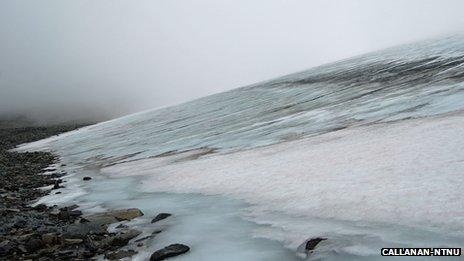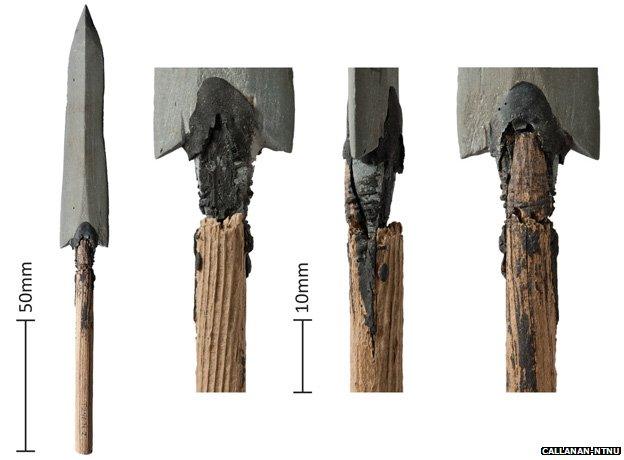Ancient artefacts found in melting snow
- Published

The well-worn tunic was incredibly well preserved and was made from wool
An Iron Age tunic is among the discoveries found under melting snow on Norwegian mountains.
Other finds include Neolithic arrows and bow fragments, thought to be about 6,000 years old.
Snow on the Norwegian mountains, and elsewhere, is rapidly melting due to climate change, which is now unveiling a world of well preserved new discoveries.
The findings are published in two papers in the journal Antiquity, external.
"The new find is of great significance for dress and textile production and how these reflect the interplay between northern Europe and the Roman world," said Marianne Vedeler from the University of Oslo, Norway, who analysed the garment.
The tunic, found on the Norwegian Lendbreen glacier, was partly bleached from sun and wind exposure. It showed hard wear and tear and had been repaired with two patches.
It was made between 230 and 390 AD and is one of only a handful of tunics that exists from this period. Two different fabrics were present and the fibre tips revealed that both were made of lamb's wool or wool from adult sheep.
"The Lendbreen tunic is a first glimpse of the kind of warm clothing used by hunters frequenting the ice patches of Scandinavia in pursuit of reindeer. It had no buttons or fastenings, but was simply drawn over the head like a sweater," said Dr Vedeler.

Snow patches are rapidly melting due to a changing climate
"The patching shows that this was not the first stage of the tunic's life; indeed, the hunter who abandoned it may not have been its first owner."
The arrows and bow fragments were much older and also found in snow patches - natural areas of snow which grow when it snows and melt in the sun.
Martin Callanan of the Norwegian University of Science and Technology, Trondheim, who authored the arrows and bow fragments paper, said: "When people lost their arrows they lost them in the snow patches."
"These are unique finds, they are a signal that something is changing up there. As snow patches are starting to melt, people are finding archaeological artefacts in all sorts of different places and they are often quite well preserved," added Mr Callanan.
The Neolithic arrows were shorter than earlier Mesolithic shafts found in Europe, possibly due to the heavy weight of the points which were made out of slate.
The artefacts were extremely well preserved for their age and fragility, but as the changing weather increases the speed at which the snow melts, other artefacts may degenerate before they are found.
"The number and antiquity of some of these artefacts is unprecedented in the almost century-long history of snow patch surveying in the region," said Mr Callanan.
"At the same time, as the climate continues to heat up and the snows melt away, one wonders what long-term price there will be to pay for these glimpses of the frozen past."

Arrow heads were thought to be lost by Neolithic hunters
- Published16 July 2013
- Published15 July 2012
- Published2 May 2012
- Published6 June 2011